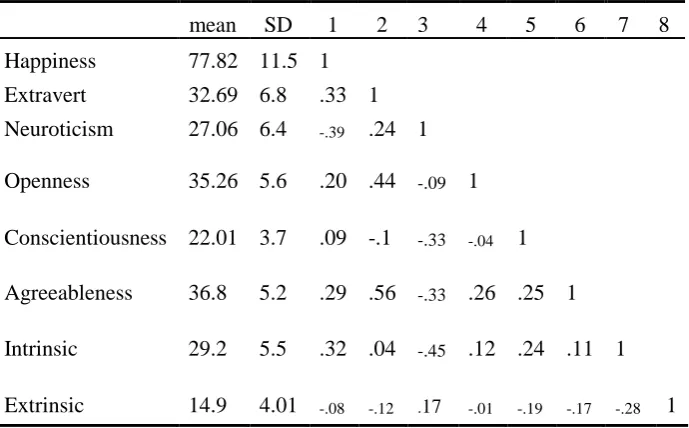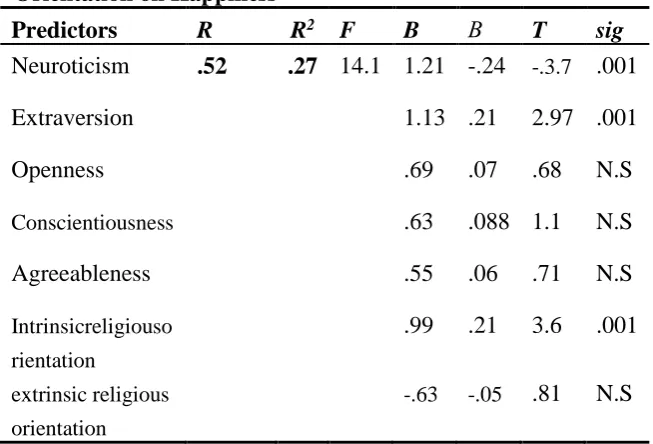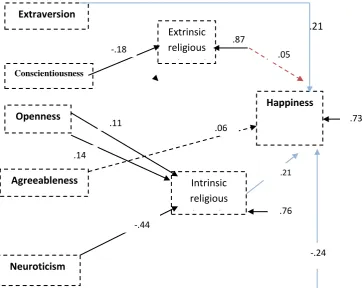IPA
International Journal of Psychology Vol. 9, No. 2, Summer & Fall 2015
PP. 76-93
Iranian Psychological
Association
The Rrelationship between the Big Five
Personality Traits and Happiness with the
Mediation Role of Religious Orientation
among Students
Ghavam Moltafet, PhD*
Department of Psychology Yasouj University
Somayeh Sadati Firoozabadi, PhD
Department of Exceptional Psychology Shiraz University
The main purpose of this study was to examine the relationships between the big five personality traits and happiness with religious orientation as a mediator. The participants consisted of 301 Shiraz University students (110 males and 191 females) selected by applying a multistage random sampling method. Participants completed three questionnaires: NEO-FFI or the short personality inventory of Costa and Mc Crae (1992); the Intrinsic-Extrinsic Religious Orientation Scale (IEROS, Allport & Ross, 1967); and the Oxford Happiness Inventory (OHI) (Argyle, 1989). These instruments showed appropriate reliability and validity. Multiple regression and path analysis were the major statistical analyses run in the study. Results of multiple regressions revealed that extraversion, and intrinsic religious orientations were the positive predictors of happiness, in contrast to Neuroticism which predicted happiness negatively. Also, results showed that religion orientation played the mediation role between these relationships. The findings indicated that this model is a proper model to explain the mechanism of the effects of personality traits on happiness. Based on the findings, to increase the level of happiness in neurotic people it would seem useful to intervene by increasing the intrinsic religious orientation.
Keywords: the big five personality traits, religious orientation, happiness, students
happiness, religious experience (Altemeyer & hunsberger, 1992). Allport (1967) has proposed two main religious orientations: intrinsic and extrinsic. Individuals with an intrinsic orientation toward religion were described as wholly committed toward their religious beliefs and that religiosity was evident in every aspects of their life. On the other hand, those with an extrinsic orientation used religion as a means to provide participation in a powerful in–group protection (Genia, 1993), consolation and social status (Allport & Ross, 1967), religious participation and an ego defense. This difference between religious orientations is said to be related to the personality traits, and this difference has an effect on happiness. For example, in a qualitative review of the relationship between religiosity and personality trait, Francis (1993, 1997) reported a negative relationship between religiosity and psychoticism. Saroglou (2002) in a meta–analysis study, using the five factors model of personality, found that general religiosity was related to extroversion, agreeableness and conscientiousness. He found that intrinsic religious orientation was related to low agreeableness, low neuroticism and low openness, while extrinsic religious orientation was related to neuroticism.
scale of Attitude toward Christianity. Some researchers revealed that intrinsic and extrinsic religious orientations predicted higher and lower levels of well-being and happiness, respectively (Francis &Wilcox, 2000; Dezutter, Socnes & Husebaut 2006; Maltby & Day 2000, 2003). In sum, studies are consistent in reporting a significant negative relationship between the intrinsic orientation toward religion and depressive symptoms and trait anxiety and a significant positive relationship between extrinsic orientation toward religion and depressive symptoms and trait anxiety (Dezutter, Socnes & Husebaut, 2006; Maltby & Day, 2000, 2003; Goodin, Kronfli, King, Glover, Sibille & Fillingim, 2012).
Although the previous studies have mainly confirmed the positive relationships of personality traits and religious orientation with happiness, they did not clearly mention the mechanism of these relationships. Therefore, the main goal of the present study is to explore the effects of personality dimensions on happiness with religious orientation as a mediation variable.
Based on our research purpose, three research hypotheses are generated:
1. There is a relationship between each of the personality dimensions and happiness.
2. There is a relationship between each of the Personality dimensions and religious orientation.
3. Religious orientation has a mediation role between personality dimensions and happiness.
Method
by the random multistage sampling method from the four faculties of Shiraz University (engineer faculty, education and psychology faculty, agriculture faculty and humanities faculty). The participants consisted of 301 bachelor Shiraz University students (110 males and 191 females) with age ranging between 18 and 24 years. All participants were informed in class that they would be asked to participate in a research study of personality, motivational beliefs and hope, and informed consent was obtained.
Measures
Three questionnaires were administered to collect the data:
Personality
Participants completed the authorized Dutch/Flemish version of the NEO-FFI which is a 60-item self-report scale with five subscales named as: Extraversion, Agreeableness, Conscientiousness, Neuroticism and Openness to Experience (Hoekstra, Ormel & Fruyt, 1996). Each subscale contains 12 five-point Likert-type items with a proper reliability Cronbach’s alpha rating from .67 to .87 for all subscales (Duriez & Soenens 2006). In this study the values of Cronbach’s alpha obtained were from .76 to .88. The results of the factor analysis showed five general factors which explained 38.51 percent of the variance. The factor loadings obtained were from .42 to .73 for the items.
items are related to Intrinsic (INT) and 11 items represent the extrinsic (EXT) scale. The psychometric qualities of IEROS produce evidence of satisfactory reliability. Values of Cronbach’s alpha were .65 to .66 for the extrinsic scale scores and .79 to .82 for the intrinsic ones (Taylor & Mac Donald, 1999; Genia, 1993). Values of Cronbach’s alpha for this study were .76 for extrinsic and .84 for intrinsic scales. Validity of the instrument has also been provided (Genia, 1993; Taylor & Mac Donald, 1999). Results of the factor analysis showed two general factors, explaining 29.6 percent of the variance. Factor loadings obtained were from .36 to .69.
Oxford Happiness Inventory (OHI). The OHI is a 29 self-rating Likert-type items, to measure the level of happiness. The OHI seems to demonstrate excellent reliability (test-retest= .78 and Cronbach’s alpha from .64 to .87 (Cheng & Furnham, 2003.). Correlations among all the happiness components (positive effects, life satisfaction, as well as negative effects, depression and distress) varied from .40 to .60 confirming acceptable validity for the measure (Cheng and Furnham, 2003). The reliability value obtained in this study (α=.76) confirmed the initial reliability of the measure. The results of the factor analysis showed one general factor (eigenvalue=8.7). This factor explained 32.51 percent of the variance. The factor loadings obtained were from .40 to .72 for items.
Results
Table 1
Means, Standard Deviations, and Correlations among the Research Variables
mean SD 1 2 3 4 5 6 7 8
Happiness 77.82 11.5 1
Extravert 32.69 6.8 .33 1
Neuroticism 27.06 6.4 -.39 .24 1
Openness 35.26 5.6 .20 .44 -.09 1
Conscientiousness 22.01 3.7 .09 -.1 -.33 -.04 1
Agreeableness 36.8 5.2 .29 .56 -.33 .26 .25 1
Intrinsic 29.2 5.5 .32 .04 -.45 .12 .24 .11 1
Extrinsic 14.9 4.01 -.08 -.12 .17 -.01 -.19 -.17 -.28 1
Predicting Happiness from Personality Traits and Religious Orientation
A simultaneous hierarchical regression, based on Baron and Kenny`s steps (1986), was applied to test the research hypotheses. Their steps required the followings:
1-Enter regression of happiness on Personality dimensions 2-Enter regression of religious orientation on Personality
dimensions 3-Enter regression of happiness on religious orientation and
Personality dimensions 4-compare steps 1 and 3
Step1
Relations between the Big Five Personality Traits and Happiness
The results of multiple regressions (enter) of happiness on personality variables are presented in Table 2.
Table 2
Multiple Regression of Personality on Happiness
Predictors R R2 F B B T sig
Neuroticism .47 .22 16.48 -.79 -.33 -5.7 .001
Extraversion .62 .18 2.6 .001
Openness .32 .08 1.24 N.S
Conscientiousness .28 .043 1.1 N.S
Agreeableness .29 .055 .87 N.S
Step 2
A). Relations between the Big Five Personality Traits and Intrinsic Religious Orientation
The results of multiple regressions (enter) of personality traits on intrinsic religious orientation are presented in Table 3.
Table 3
Multiple Regression of Personality on Intrinsic Religious Orientation
Predictors R R2 F B Β T sig
Neuroticism .49 .24 18.3 -.1.1 -.44 -.7.79 .001
Extraversion .52 .088 1.32 N.S
Openness .71 .14 2.42 .001
Conscientiousness .67 .11 2.01 .001
agreeableness .34 ..04 .68 N.S
As the results of Table 3 shows the initial multiple regression was significant ((F=18.3; P<.001; R2= .24) Results of enter
regression procedure indicated that neuroticism (β=..44, t= -7.79, p<.001), openness (β=.14, t= 2.42, p<.001.) and conscientiousness (β=.11, t= 2.01, p<.001) significantly predicted the intrinsic religious orientation as a dependent variable.
B). Relations between the Big Five Personality Traits and Extrinsic Religious Orientation
Table 4
Multiple Regression of Personality on Extrinsic Religious Orientation
Predictors R R2 F B Β T sig
Neuroticism
.36 .13 8.86
99 .09 1.34 .083
Extraversion .42 .05 .79 N.S
Openness .71 .08 .87 N.S
Conscientiousness -.98 -.18 -.3.7 .001
agreeableness .35 .04 .68 N.S
As the results of Table 4 shows the initial multiple regression was significant (F=8.86; P<.001; R2=13). Results showed that
conscientiousness (β=.-.18, t= -3.7, p<.001) was a negative significant predictor of the extrinsic religious orientation.
Predicting Happiness from Personality Traits and religious Orientation
Step3
Applying the third step of the multiple regression, all variables were entered together to predict happiness. The purpose of this step was to identify the role of the religious orientation as a mediator variable.
Table 5
Multiple Regressions of Personality and Religious Orientation on Happiness
Predictors R R2 F B Β T sig
Neuroticism .52 .27 14.1 1.21 -.24 -.3.7 .001
Extraversion 1.13 .21 2.97 .001
Openness .69 .07 .68 N.S
Conscientiousness .63 .088 1.1 N.S
Agreeableness .55 .06 .71 N.S
Intrinsicreligiouso
rientation
.99 .21 3.6 .001
extrinsic religious
orientation
-.63 -.05 .81 N.S
Step 4
Comparing the results of steps 1 and 3 indicates that religious orientation plays a significant mediator role between personality traits and happiness. The total model, after eliminating no significant relationships, is shown in Figure1.
Figure 1
The Total Model
Discussion
The main goal of this study was to investigate the relationship between the five-factor model of personality and happiness with the mediator role of religious orientation. Results of this study, initially, supported the first hypothesis. Consistent with the previous studies in the field, neuroticism was negatively related to happiness and extraversion was positively related to happiness. Similar results were obtained by (Eysenck, 1990; Argile, 1990; Furnham and Cheng, 2000; Cheng, and Furnham, 2003; Francies, 2000; Mazidi & Ostovar, 2006;
0.73
.21
Happiness Extraversion
-.24 .21
Conscientiousness
Agreeableness
Neuroticism
Extrinsic religious orientati
on
Intrinsic religious orientation -.18
-.44 .14
.11
.87
.76 Openness
.06
.05
khanzade, Moltafet & Sadati, 2007). The above researchers have shown that extraversion and neuroticism had direct effects on happiness. Results of this study provided support for the first hypothesis.
In order to examine the relationship between personality traits and religious orientations, two separate regressions were performed; one for intrinsic and another for extrinsic religious orientations. Results of the regression procedure revealed that conscientiousness, and openness were positively, and neuroticism was negatively related to intrinsic religious orientation. However, conscientiousness predicted extrinsic religious orientation negatively. Previous researchers such as Francies (1992), Lewis & Maltby (1995), Maltby (1999) and Gorm (2004) supported our results and showed that psychoticism and neuroticism were negatively related to intrinsic religious orientations. Therefore, the findings that conscientiousness and openness were positively related to intrinsic religious orientation are unique.
Since the main goal of this study was to explore the relationship between personality traits and happiness, with religious orientation as a mediator variable, we performed regression procedures to predict happiness using all research variables. The results of regression showed that religious orientation plays a mediation role between personality traits dimensions and happiness nicely. Previous researchers such as Francis (2000, 2002); maltby & Day (2003) and mazidi & Ostovar (2006) supported our results and showed that religious orientation was related to well-being and happiness.
explain the mechanism of the effects of personality traits on happiness. In sum, the present study adds to the growing body of literature surrounding personality and it outcomes. It demonstrates that the unique influence of the separate components of religious orientation on happiness and religious orientation depends on the personality. In order to increase the level of happiness in neurotic people it would seem useful to intervene by increasing intrinsic religious orientation. In other words, one way to help people to better "pursue happiness" may be to help them to better identify and pursue personal goals such as intrinsic religious orientation .The model applied in this study has an important implication for future research, especially research on religiosity. The finding that religion orientation plays a significant role on the relationship between personality traits (big five) and happiness, has more illuminated the nature of this relation. Also it seems that individual’s happiness is, to some degree, affected by his/her religious orientation. Individuals with an intrinsic religious orientation were happier than those with an extrinsic orientation. Therefore, it is recommended that the ground for experiencing more intrinsic religious orientation should be provided for the people. Results of this study are limited to the population from which our research sample was selected. Therefore, generalizations of our findings to other groups, in Iran, or individuals in other countries are not recommended. Further, studies should check this model to verify whether it is applicable to cultural settings other than the Islamic tradition or not.
References
Altemeyer, B., & Hunsberger, B. (1992). Authoritarianism, religious, fundamentalism, Quest and prejudice. The International Journal for the Psychology of Religion, 2,
113-133.
Argyle, M., Martin, M., & Crossland, J. (1989). Happiness as a function of personality and social encounters. In J. P. Forgas & J. M. Innes (Eds.), Recent advances in Social Psychology: An international perspective (pp. 189–203). New York: Elsevier North-Holland.
Argyle, M. (2001). The psychology of happiness. London. Rutledge.
Argyle, M. (1990). The happiness of extraverts. Personality and Individual Differences, 11, 1011-1017.
Baron, R. M., & Kenny, D. A. (1986). The moderator-mediator variable distinction in social psychological research: Conceptual, strategic, and statistical considerations.
Journal of Personality and Social Psychology, 51, 6, 1173. Batson, C., Schoenrade, P., & Ventis, W. L. (1993). Religion
and individual: A social-psychological perspective. New York: Oxford university press.
Cheng, H., Furnham, A. (2003). Dimension of personality, domain of aspiration, and subject well-being. Personality and Individual Differences, 34, 921-942.
Costa, P. T., & McCrae, R. R. (1992). Revised NEO personality inventory PI-R) and Neo five factor inventory (NEO-FFi). Professional Manual. Odessa: Psychological assessment resources.
Diener, E. (1985). The satisfaction with life scale. Journal of personality and assessment, 49, 71.75
Diener, E., Suh, E. M., Lucas, R. E., & Smith, H. L. (1999). Subjective well-being: Three decades o progress.
Duriez, B., & Sonens, B. (2006). Personality, identity styles, and religiosity: An integrative study among late and middle adolescents. Journal of Adolescence, 29, 119-135.
Emmons, R. A., & Diener, E. (1985). Personality correlates of subjective well-being. Personality and Social Psychology Bulletin, 11, 89–97.
Eysenck, M. (1990). Happiness, facts, and myths. London:LEA Francis, L. j. (1992). Is psychoticism really a dimension of
personality fundamental to religiosity? Personality and Individual Difference, 35, 501-518.
Francis, L. j. (1993). Personality and religion among college students in the U. k. Personality and individual differences, 14, 619-662.
Francis, L. j. (1997). Personality, prayer and church attendance among undergraduate students. International Journal for Psychology of Religion, 7(2), 127-132
Francis, L. J., & Wilcox, C. (2000). Religiosity and happiness: during adolescence, young adulthood and later life. Journal of psychology and Christianity, 19, 245-257.
Francis, L. J., & Katz, Y.J. (2002). Religiosity and happiness: a study among Israeli female undergraduates. Research in the Social Scientific Study of Religion, 13, 75-86.
Francis, L.j., & Robbins, M. (2000). Religion and happiness: a study in empirical theology. Transpersonal Psychology Review, 4, 17-22.
Furnham, A., & Cheng, H. (2000). Perceived parental behavior, self-esteem and happiness. Social Psychiatry and Psychiatric Epidemiology, 35, 463-470.
Gartner, J., Larson, D. B., & Allen, G. D. (1991). Religious commitment and mental health: a review of the empirical literature. Journal of Psychology and Theology, 19(1), 6-25
I/E scale in a religiosity heterogenous sample. Journal for the Scientific Study of Religion, 32(3), 284-290.
Goodin, B. R., Kronfli, T., King, C. D., Glover, T. L., Sibille, K., & Fillingim, R. B. (2012).Testing the relation between dispositional optimism and conditioned pain modulation: Does ethnicity matter? Journal of Behavioural Medicine, 35, 1–10.
Gorm, A.F.,& Christensen,E. (2004). Religiosity and personality: evidence for non-linear associations.
Personality and Individual Differences, 36, 1433-1441. Hoekstra, H., Ormel, J., & De Fruyt, F. (1996). NEO
persoonlijkheidsvagenlijsten NEO-PI-R en NEO_FFI handleiding [NEO_-PI-R and NEO_FFI. Manual]. Lisse:Swets&Zeitlinger.
Khanzade, A. H., Moltafet, GH., & Sadati, S. (2007). Relationship between dimension of personality and happiness. Journal of Psychology Science, 5(20), 337-351. Lewis, C. A., & Maltby, J. (1995). Religiosity and personality
among U. S. adults. Personality and Individual Differences, 18, 293-295.
Laurencell, R. M., Abell, S., & Schwartz, D. J. (2002). The relation between intrinsic religious fait hand psychological well-being. The International Journal for Psychology of Religious, 12, 109-123.
Maltby, J. (1999). Religious orientation and Eysenck personality dimension: the use of the amended religious orientation scale to examine the relationship between religiosity, psychoticism, neuroticism and extraversion. Personality and Individual Differences, 26, 79-84.
correlates of depression. Personality and Individual Difference, 28, 383-393.
Maltby, J., & Day, L. (20003). Religious orientation, religious coping and appraisal of stress. Personality and Individual Differences, 34, 1029-1039.
Mazidi, M., & Ostvar, S. (2006). Effect of religion and type of religious internalization on the mental health of Iranian adolescents. Perceptual and Motor Skills, 103, 301-306. Ozkan, H., & Arikan, A. (2009). Internet censorship in Turkey:
University students' opinions.World Journal on Educational Technology,1(1) 46–56.
Saroglou, V. (2002). Religion and the five factors of personality: Meta–analytic review. Personality and Individual Differences, 32, 15-25.
Snyder, C. R. (2002). Hope theory: Rainbows in the mind. Psychological Inquiry: An International Journal for the Advancement of Psychological Theory, 13, 249–275. http://dx.doi.org/10.1207/S15327965PLI1304_01.
Taylor, A., & McDonald, D. A. (1999). Religion and five- factor model of personality: An exploratory investigation using a Canadian university sample. Personality and Individual Differences, 27, 1243-1259.


